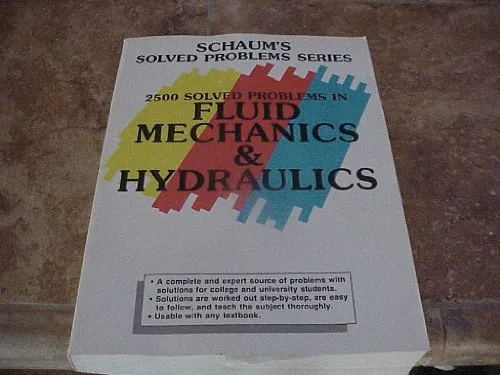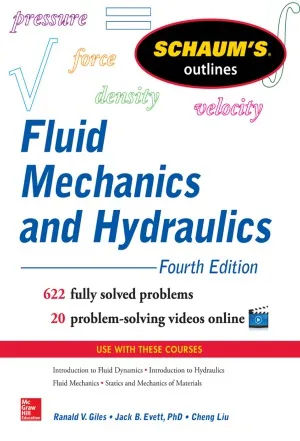Handbook of Hydraulic Resistance. Coefficients of Local Resistance and of Friction
4.5
Reviews from our users

You Can Ask your questions from this book's AI after Login
Each download or ask from book AI costs 2 points. To earn more free points, please visit the Points Guide Page and complete some valuable actions.Related Refrences:
Introduction to the Handbook of Hydraulic Resistance: Coefficients of Local Resistance and of Friction
"Handbook of Hydraulic Resistance: Coefficients of Local Resistance and of Friction" by Idel'chik I.E. serves as a comprehensive reference for engineers, researchers, and students involved in the design and analysis of fluid systems. It focuses on the resistance exerted by fluid flow in various hydraulic systems and components, providing practical coefficients, empirical formulas, and theoretical justifications for addressing real-world challenges. This book has played an essential role in shaping our understanding of hydraulics and remains a widely used resource in the industry, offering cutting-edge solutions for dealing with local resistance and friction in pipes, valves, and fittings.
Summary of the Book
The handbook is an authoritative text on the principles and practical applications of hydraulic resistance. It delves into the complexities of fluid movement through pipes and other conduits, analyzing how flow resistance emerges from a variety of conditions and geometries. Beginning with the theoretical groundwork, the book progresses into the methodology for determining coefficients of local resistance and friction. One of the strengths of the book lies in its balance between mathematical rigor and user-driven applicability. It provides an extensive collection of empirical data along with detailed explanation tables for engineers to calculate pressure loss accurately. Topics covered include laminar and turbulent flows, resistance estimations for bends, valves, tees, reducers, manifolds, and other local obstacles present in hydraulic systems. This handbook’s detailed data sets allow practitioners to avoid costly errors when designing systems. The extensive tabulation system and clear presentation of information ensure that this guide remains an invaluable asset to anyone working in mechanics or fluid dynamics, whether they are students, experienced engineers, or technical consultants.
Key Takeaways
- Provides a clear and reliable method for estimating coefficients of local resistance and coefficients of friction in hydraulic systems.
- Includes detailed breakdowns of empirical formulas for tackling various practical situations.
- Incorporates both theoretical derivations and experimental data to ensure accuracy and applicability to real-world engineering.
- Offers extensive insights into flow regimes such as laminar, transition, and turbulent flows, helping readers understand how these affect hydraulic resistance.
- Features practical guidance on minimizing energy loss in fluid operations through an optimized design of pipe systems and components.
- Contains practical tools such as coefficient tables and resistance charts, making it highly usable in daily engineering tasks.
- This resource streamlines workflow for hydraulic engineers by providing one of the most comprehensive data references available.
Famous Quotes from the Book
"Accuracy and precision in the selection of hydraulic resistance coefficients are fundamental to the success of any fluid dynamics system."
"Every turn, fitting, or surface irregularity in a pipe system represents not only a physical obstacle but also an economic challenge due to potential energy losses."
"The true art of hydraulic engineering lies not just in moving a fluid but in doing so efficiently and economically, with minimal total loss."
Why This Book Matters
The "Handbook of Hydraulic Resistance" is essential for several reasons. First and foremost, it bridges the gap between academic theory and industrial practice. Its in-depth coverage of hydraulic flows and resistance empowers professionals to design more efficient, cost-effective systems. The meticulously compiled tables of coefficients for various components make it a go-to resource in academia and industry alike. Furthermore, the book's relevance extends across a wide array of disciplines, including mechanical engineering, civil engineering, petroleum engineering, and environmental science. Practitioners designing water utilities, oil pipelines, HVAC systems, or chemical transport systems will find the book indispensable for crafting systems that minimize losses and withstand practical operational demands. Lastly, the book promotes a better understanding of sustainable hydraulic engineering by emphasizing energy efficiency. As hydraulic systems constitute a major part of many infrastructure projects, optimal designs informed by this handbook can substantially reduce energy consumption, mitigating environmental impact while saving costs. In summary, "Handbook of Hydraulic Resistance" is more than just a technical guide. It is a foundational text for anyone looking to excel in the field of fluid mechanics and system optimization.
Free Direct Download
You Can Download this book after Login
Accessing books through legal platforms and public libraries not only supports the rights of authors and publishers but also contributes to the sustainability of reading culture. Before downloading, please take a moment to consider these options.
Find this book on other platforms:
WorldCat helps you find books in libraries worldwide.
See ratings, reviews, and discussions on Goodreads.
Find and buy rare or used books on AbeBooks.
1280
بازدید4.5
امتیاز0
نظر98%
رضایتReviews:
4.5
Based on 0 users review
Questions & Answers
Ask questions about this book or help others by answering
No questions yet. Be the first to ask!











![Fundamentals Of Software Engineering, 5Th Ed [Paperback] Mall](https://s3.refhub.ir/images/thumb/Fundamentals_Of_Software_Engineering__5Th_Ed__31573.webp)

